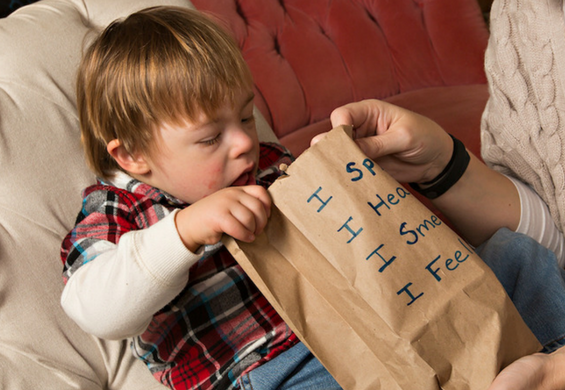
27 Feb Stay In, and Let the Games Begin: 10 Indoor Learning Activities for Preschoolers
Like a little sponge, your child may have already soaked up all the fun and learning in this month’s box of Dilly’s Tree House family engagement system. If that’s the case, you might be wondering what to do to keep the fun going—especially when there’s no fun to be found outside. Don’t lose hope. Beat the winter blues with these indoor learning activities that not only satisfy your child’s aversion to boredom, but will also keep him physically and mentally fit all winter long.
When the weather takes a turn for the worse, give these preschool indoor learning activities a turn.
-
I Spy, I Hear, I Smell, I Feel
Materials: none
Time: 5–15 minutes
We use our eyes to see, ears to hear, nose to smell, fingers to touch, and mouths to taste. Invite children to use their senses to guess some objects that you describe. Use clues such as these for a game of “Five Senses I Spy.”
I spy with my little eye…
Something that is black, shiny, and a rectangle. (television)
I hear with my little ear…
Something that is chirping softly. (bird)
Continue the game, giving clues about items that can be felt, smelled, or touched for the setting you are in. Your child can also give you clues, so he can practice describing objects and sounds.
Challenge: Place a variety of objects in a bag and have children guess what they are by reaching inside to feel them.
What can your child learn? Not only can this learning activity be done indoors with no prep, it strengthens children’s oral language skills by encouraging them to listen to and understand descriptions. It also builds science skills by developing their understanding of their five senses.
-
Who Tells Your Story?
Materials: paper, stapler, crayons
Time: 15–20 minutes
Children are full of stories. True stories about their family, their pets, and their friends. Fanciful stories about faraway lands and magical creatures. Mysterious stories with riveting plot twists.
They just need some help writing them down. Consider Dorothy Straight. Her mother urged her to write about how the world began, and she wrote and drew the story to become the youngest published writer ever. Gather a few sheets of paper, fold them in half, and staple them together at the crease to form a book. Then act as a scribe as your child tells her story. Be sure to leave room on each page so your child can illustrate. Then create an “About the Author” page for the back cover of the book.
Challenge: Have children write one or two words on their own on each page.
What can your child learn? This indoor learning activity builds literacy skills as well as confidence and self-esteem. And maybe the next top-selling novelist!
-
Dye-ing to Stay Inside
Materials: paper towels, food coloring
Time: 10–15 minutes
Create dazzling abstract art together. Gather paper towels and some food coloring. Lay at least three paper towels on top of one another on a table. Have your child pick 3 or 4 colors of food coloring and help them drop individual drops on the top paper towel. Watch as the color expands and blends with the other colors. As the paper towel is drying, pick up the top towel to see how the color is brightest on the top layer.
Challenge: Ask your child to predict what they think will happen before they drop the color and before they see the bottom layers of paper towels.
What can your child learn? This indoor project is part art and part science. As the color expands, explain what you see with science words such as expand, liquid, absorb. They’ll love using fancy words to describe their fancy project!
-
Sort Something
Materials: ice cube tray, egg container, or muffin tin, small items to sort such as dried beans, cheerios, torn pieces of construction paper, or coins.
Time: 10–15 minutes
Keep your child on his toes with this indoor sorting game. Place the sorting container and the small items in front of your child. Call out different ways for him to sort: by color, size, pattern, weight, etc. When she gets tired of sorting, then ask her to make patterns with the items. You can ask her to make a simple A-B pattern (bean, coin, bean, coin), or you can ask your child to make up a pattern of her own and explain it to you.
Challenge: Call out increasingly difficult patterns, moving from A-B, to A-B-C, to A-B-C-D, and see how far she can go.
What can your child learn? Sorting games are a nice choice for an indoor game because there are tons of possibilities and no right answers. They blend logical thinking and mathematical reasoning with creativity.
-
Making Music
Materials: dried beans, paper clips, or coins, bag or plastic container with lid, rubber bands, shoe box
Time: 10–15 minutes
Everyone loves music. And when you have a little extra indoor time on your hands, why not make your own instruments? Gather small solid items such as dried beans, paper clips, or coins. Then put these in a plastic bag or plastic container with a lid for instant maracas. Then gather a shoe box and rubber bands. Stretch the rubber band around the shoe box to make a stringed instrument. Anything that makes noise can be an instrument. Once you’ve made your instruments, play your favorite music and pretend like you are part of the band.
Challenge: Don’t tell your child how to make the instrument. Give her the materials and ask her how she can use these materials to make sound. Let her try to figure it out on her own.
What can your child learn? Free play with homemade instruments not only beats the winter blues, but builds children’s sense of music and rhythm.
-
Country Collage
Materials: printouts form Internet search for images of a specific country, poster board or several pieces of paper, glue stick
Time: 15-20 minutes
It’s never too early to introduce children to the great wide world we live in. Choose a country that interests you and then do an Internet search with your child for images from that country. Choose a few categories, such as food, clothing, customs, language, holidays, currency, or landmarks. Think aloud as your child watches you search for images. “I wonder what money looks like in China. I’m going to search for ‘China currency.’” Print 3-4 images for each category. Once you have your images, it’s time to make the collage. Write the category name on the poster board (or do one category per piece of paper if you don’t have poster board). Then have your child glue the images that go with that category onto the poster board. Once you have all the images glued, hang the board up and talk about what you see. What is alike and different from the United States?
Challenge: Do two countries and compare.
What can your child learn? Giving children an early sense of world cultures builds empathy and understanding, a critical social and emotional skill. This activity is also a nice way to teach your child that computers are not just for entertainment, but a means to find answers and learn new things.
-
Walk the Line
Materials: masking tape or painter’s tape
Time: 10-15 minutes
Being stuck inside doesn’t mean you can’t be active. Tape a line on the floor. Ask your child to walk along it, trying to balance as best he can. Then challenge him to do it backwards. Then tape the line in different ways, such as a zig zag or a curve. If that’s too easy, tape X’s on certain parts of the line and call out a different movement whenever he gets to the Xs (a jumping jack or a tuck jump).
Challenge: Have your child tape the line himself. Add other obstacles such as pillows and other soft surfaces.
What can your child learn? It’s important to keep up gross motor skills even during the winter months when children don’t tend to get as much playground time. This indoor learning activity will keep your little one moving strong.
-
Shape Hunt
Materials: cans, books, cell phone, cups, paper, pencil
Time: 10-15 minutes
Help your child see that shapes are all around by using common household items as inspiration. Turn a cup over on a piece of paper and trace the edges to form a circle. Then send your child on a hunt for more household items that can make a circle. Then do the same thing with a square, a rectangle, and so on. If you can’t find a shape in your house, go to the Internet and do a search. Search for things like “images of hexagon in real life” or “images of triangle in real life” and watch your child discover all the places shapes show up in our everyday world.
Challenge: Have your child create her own shape template.
What can your child learn? Understanding shapes prepares children for mathematical and special reasoning. This indoor learning activity also helps them understand the relevance of math to their own life.
-
Melted Crayons
Materials: crayons, muffin tin
Time: 15-20 minutes
Teach children the art of upcycling by taking old, broken crayons and turning them into something new. Unwrap the crayons, and arrange them in a muffin tin in a single layer. Then bake at 200 degrees for about 10 minutes. Let them cool, then stick them in the freezer so they will pop out easily. Just turn the pan over and you’ll have new round crayons. Mix colors for an artistic project and use it as a paperweight or living room décor.
Challenge: Have your child predict what will happen when the crayons go in the oven and then in the freezer. Discuss the concept of heat expanding and cold shrinking.
What can your child learn? Witnessing matter change forms from solid to liquid is a memorable experience that will stay with your child when they study physical science in school.
-
Freeze Dance
Materials: music player with ability to pause and resume
Time: 10-20 minutes
Keep kids moving through the winter with a game of freeze dance. Play their favorite song and have them bust a move until you stop the music. When you stop the music, they have to freeze. Have as much fun as you like making them hold their frozen position. Then resume the music and keep the fun going.
Challenge: Assign a theme to each freeze. “Next time the music stops, freeze with a sad face.”
What can your child learn? This indoor game helps children learn to focus and pay attention as well as keep their bodies active and fit.
And remember, you’re not alone. There’s a whole community of parents out there looking to keep their little ones active and engaged all winter long. Check out these Pinterest boards for some more great ideas from your fellow moms and dads!
Of course, there’s nothing like a good change of venue to keep your little one engaged and active. But when outdoor play is not an option, you needn’t brace yourself for a day of tantrums, boredom, or mischief. Instead, let the preschool indoor learning activities begin, and keep your little one moving her mind and body all the way to summer.

Sorry, the comment form is closed at this time.